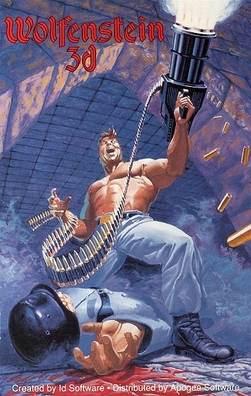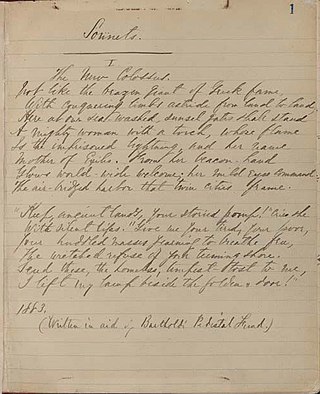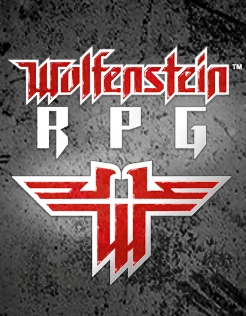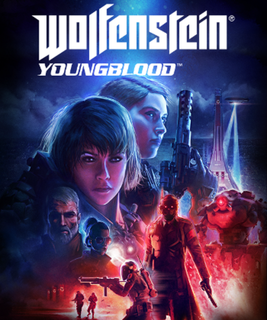
Return to Castle Wolfenstein is a first-person shooter video game published by Activision, released on November 20, 2001, for Microsoft Windows and subsequently for PlayStation 2, Xbox, Linux and Macintosh. The game serves as a reboot of the Wolfenstein series. It was developed by Gray Matter Studios and Nerve Software developed its multiplayer mode. id Software, the creators of Wolfenstein 3D, oversaw the development and were credited as executive producers. The multiplayer side eventually became the most popular part of the game, and was influential in the genre. Splash Damage created some of the maps for the Game of the Year edition. A sequel, titled Wolfenstein, was released on August 18, 2009.

Wolfenstein 3D is a first-person shooter video game developed by id Software and published by Apogee Software and FormGen. Originally released on May 5, 1992, for DOS, it was inspired by the 1981 Muse Software video game Castle Wolfenstein, and is the third installment in the Wolfenstein series. In Wolfenstein 3D, the player assumes the role of Allied spy William "B.J." Blazkowicz during World War II as he escapes from the Nazi German prison Castle Wolfenstein and carries out a series of crucial missions against the Nazis. The player traverses each of the game's levels to find an elevator to the next level or kill a final boss, fighting Nazi soldiers, dogs, and other enemies with a knife and a variety of guns.

Castle Wolfenstein is a 1981 action-adventure game developed by Silas Warner for the Apple II and published by Muse Software in 1981. It is one of the earliest games based on stealth mechanics. A port to Atari 8-bit computers was released in 1982, followed by Commodore 64 (1983) and MS-DOS (1984).

"The New Colossus" is a sonnet by American poet Emma Lazarus (1849–1887). She wrote the poem in 1883 to raise money for the construction of a pedestal for the Statue of Liberty. In 1903, the poem was cast onto a bronze plaque and mounted inside the pedestal's lower level.

Debra Renee Wilson is an American actress and comedian. She is the longest-serving original cast member on the sketch comedy series Mad TV, having appeared on the show's first eight seasons from 1995 to 2003. As a voice actress, she has voiced various characters on television and video games, including Mao Mao: Heroes of Pure Heart, Baby Shark's Big Show!, Spitting Image, Mirror's Edge Catalyst, Wolfenstein, Star Wars Jedi: Fallen Order, Star Wars Jedi: Survivor, Halo Infinite, and Diablo IV.
Wolfenstein is a series of World War II video games originally developed by Muse Software. The majority of the games follow William "B.J." Blazkowicz, an American Army captain, and his fight against the Axis powers. Earlier titles are centered around Nazis attempting to harness supernatural and occult forces, while later games are set in an alternate history in which Axis powers won World War II.

William Joseph "B.J." Blazkowicz is a fictional character and the protagonist of the Wolfenstein series of alternate history video games starting with 1992's Wolfenstein 3D. An American spy of Polish and Jewish descent, he specializes in one-man missions behind enemy lines. In addition to fighting the regular German army he also frequently encounters bizarre Nazi experiments concerning biomechanical technology and the occult.

Wolfenstein is a first-person shooter video game developed by Raven Software and published by Activision, part of the Wolfenstein video game series. It serves as a loose sequel to the 2001 entry Return to Castle Wolfenstein, and uses an enhanced version of id Software's id Tech 4. The game was released in August 2009 for Microsoft Windows, PlayStation 3 and Xbox 360.

Wolfenstein RPG is a first-person shooter and role-playing video game developed by id Software and Fountainhead Entertainment, released in September 2008 for mobile phones and in May 2009 for iOS.

A hypothetical military victory of the Axis powers over the Allies of World War II (1939–1945) is a common topic in speculative literature. Works of alternative history (fiction) and of counterfactual history (non-fiction) include stories, novels, performances, and mixed media that often explore speculative public and private life in lands conquered by the coalition, whose principal powers were Nazi Germany, Imperial Japan, and Fascist Italy.

Selma Engel-Wijnberg was one of only two Dutch Jewish Holocaust survivors of the Sobibor extermination camp. She escaped during the 1943 uprising, hid in Poland, and survived the war. Engel-Wijnberg immigrated to the United States from Israel with her family in 1957, settling in Branford, Connecticut. She returned to Europe again only to testify against the war criminals of Sobibor. In 2010 she was in the Netherlands to receive the governmental honour of Knight in the Order of Oranje-Nassau.
Wolfenstein 1-D is a demake of the video game Wolfenstein 3D created by American developer Mike Lacher that features the game in a minimalist one-dimensional style. It features the same character, William "B.J." Blazkowicz, and plot from the 1992 video game, but in a single line of pixels, where different colored pixels denote doors, enemies, ammo, health, and fired bullets. The game received overall positive reviews, along with comments about whether it was meant to be taken as a critique on modern 3D gaming.

MachineGames Sweden AB is a Swedish video game developer based in Uppsala. The studio was founded in 2009 by seven former employees of Starbreeze Studios, including founder Magnus Högdahl. After unsuccessfully pitching game ideas to several publishers, MachineGames agreed with Bethesda Softworks to develop an entry in the Wolfenstein series in July 2010 and was acquired by Bethesda's parent company, ZeniMax Media, in November. In the Wolfenstein series, MachineGames developed The New Order (2014), The Old Blood (2015), The New Colossus (2017), Youngblood (2019), and Cyberpilot (2019). The studio is developing Indiana Jones and the Great Circle (2024) as well as another Wolfenstein game.

Wolfenstein: The New Order is a 2014 action-adventure first-person shooter video game developed by MachineGames and published by Bethesda Softworks. It was released on 20 May 2014 for PlayStation 3, PlayStation 4, Windows, Xbox 360, and Xbox One. The game is the seventh main entry in the Wolfenstein series, set in an alternate history 1960s Europe where the Nazis won the Second World War. The story follows war veteran William "B.J." Blazkowicz and his efforts to stop the Nazis from ruling over the world.
Nina Franoszek is a German-American actress and film and theater director. Franoszek was awarded an Adolf Grimme Award for "Outstanding Lead Actress in a Drama Series" for her performance in the TV miniseries Sardsch (1998).

Wolfenstein: The New Order is the soundtrack to the video game Wolfenstein: The New Order. The soundtrack was released on 19 May 2014, consisting of an original score featured in the game. Composer Mick Gordon took inspiration from multiple sources while producing the soundtrack, ultimately creating over six hours of music. Critical reception to the soundtrack was positive, as reviewers considered that the music had been appropriated effectively for gameplay.

Wolfenstein: The Old Blood is an action-adventure first-person shooter video game developed by MachineGames and published by Bethesda Softworks. It was released on 5 May 2015 for PlayStation 4, Windows, and Xbox One. The game is a stand-alone title in the Wolfenstein series and a prequel expansion to 2014's Wolfenstein: The New Order, set in an alternate-history 1946. The single-player story follows war veteran William "B.J." Blazkowicz and his efforts to discover the locations of a Nazi compound. Development began in 2014, soon after the release of The New Order.

Wolfenstein II: The New Colossus is a 2017 action-adventure and first-person shooter game developed by MachineGames and published by Bethesda Softworks. The eighth main entry in the Wolfenstein series and the sequel to 2014's Wolfenstein: The New Order, the game is set in an alternate history that takes place in 1961, following the Nazi victory in the Second World War. The story follows war veteran William "B.J." Blazkowicz and his efforts to fight against the Nazi regime in the United States. Gameplay mechanics are largely similar to those of The New Order, though the team introduced improvements such as allowing players to dual-wield any combination of weapons in the game. A binary choice in the prologue alters the game's entire storyline; some characters and small plot points are replaced throughout the timelines.

Wolfenstein: Youngblood is a 2019 first-person shooter developed by MachineGames and Arkane Lyon and published by Bethesda Softworks. A spin-off of the Wolfenstein series, the game was released for Windows, Nintendo Switch, PlayStation 4, and Xbox One in July 2019 and Stadia in November 2019 as a launch title. The game received mixed reviews from critics who felt it was a step down from previous installments, although some reviewers praised the combat.

Wolfenstein: Cyberpilot is a first-person shooter video game developed by Arkane Lyon in conjunction with MachineGames and published by Bethesda Softworks. A spin-off in the Wolfenstein series, Cyberpilot is a virtual reality experience. The game was released for Windows PC and PlayStation 4 in July 2019. It received mixed or average reviews upon release.

















